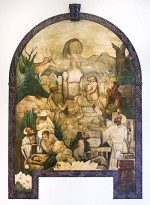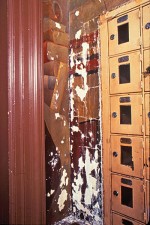Column Name
Title

Three sections of Vertis Hayes’s eight-panel series The Pursuit of Happiness.
Early in 1936, as the United States continued to be mired in the Great Depression, the Federal Art Project hired a group of African-American artists who proposed to depict the history of black people in the United States on the walls of Harlem Hospital. The project had been created the year before as part of the Works Progress Administration, itself part of President Franklin D. Roosevelt’s New Deal, an all-encompassing plan to put Americans back to work. Although it only lasted for a few years, the project was responsible for the creation of more than 5,000 jobs and 225,000 artworks. It was also where a number of American artists who would later become well-known—including Arshile Gorky, Willem deKooning, James Brooks, and Jackson Pollock—would get their start.
Body
Even though federal and city officials approved the plans for the Harlem Hospital murals, the white hospital superintendent, Lawrence Dermody, rejected the plans on the grounds that, he said, they had “too much Negro subject matter” and added that, 25 years hence, the neighborhood might not even be predominantly “Negro.” In order to justify his racist rejection, he attempted to enlist local black leaders to object to the subject matter. However, his warped thinking backfired—publicity about it aroused sympathy for the artists—and he backed down and the hospital installed the murals as planned. Today in 2013, we would at least like to believe that the very idea that a white administrator could have done such a thing is unthinkable.
The inspiration for this month’s column arises from the fact that Harlem Hospital has recently re-restored and celebrated these intriguing and historical mural paintings from the New Deal Era in its new, state-of-the-art Mural Pavilion, which administrators say will soon be open to the public.
During the 1970s, when I began writing my doctoral dissertation about W.P.A. murals, I had no way of knowing that many of the paintings would be not only relevant but also fascinating to people more than 40 years later. Unfortunately, at the time of my research, most art world individuals as well as many less-informed members of the general public dismissed W.P.A. style as old-fashioned and even inferior art.
But the fact remains that during the Depression, the U.S. government supported artists in what was arguably the most meaningful and enlightened cultural endeavor in our history: it paid regular salaries to visual artists recognizing that they, like other workers, had a right to make a living. (Writers, musicians, and playwrights were also paid through related W.P.A. projects.) During this incredibly democratic era, visual artists had a great deal of freedom. Contrary to what many people later thought, the funded works of art by no means all showed rural scenes or socially relevant ones; rather, they ran the gamut from Mexican-influenced murals to abstract and even surrealist paintings.
At the time that I began writing about the W.P.A., many of the artists were still alive, and I had the opportunity to speak with a number of them. They all expressed gratitude and respect for that golden era. My dissertation concentrated on the 200-some mural paintings in New York City’s five boroughs on walls of schools, libraries, hospitals, airports, and other municipal buildings. Of those, perhaps 25 percent still exist. Many were destroyed through neglect or outright vandalism. (There are two important murals that had once been thought lost, but which it turned out had been covered over with paint for years: Gorky’s mural, which is now at the Newark Museum, and Flight by James Brooks, which is at LaGuardia Airport’s Marine Terminal.)
Among the murals I researched, the Harlem Hospital ones were especially intriguing. I first found documentation of their existence in the Municipal Archives, which were at that time located in the attic of City Hall. The yellowed and brittle artists’ proposals and photos literally crumbled under my fingers. I telephoned the hospital to find out whether murals were still on the walls, and a trip there in the early 1970s revealed that some of them were still there, though badly deteriorating, but that others seemed to have disappeared.
At that time I walked in to the once proud and stately entrance to the hospital’s women’s pavilion to find two panels painted by Charles Alston (1907-77) facing each other. The two paintings, each measuring 6 by 17 feet, depicted magic and superstition on one hand and modern medicine on the other. Installed over radiators, they had been almost completely obscured by years of accumulated grime and dirt, but Alston, a major educator and artist during the Harlem Renaissance, subsequently told me that since he had painted them in oil on canvas, they could be restored. The space allotted me here restricts my discussion of these majestic works in detail, but I should point out that Alston used them to investigate his love of science and his interest in African culture. One especially startling fact is that the “nurse” he painted holding a baby was actually his wife, who was at the time doing her internship in surgery at the hospital. He made her a nurse, he told me, because he didn’t think people would have believed that a black woman could be a surgeon.
The second set of murals I found lined the main corridor of the nurses’ residence, on the other side of the building. Called The Pursuit of Happiness, the murals were painted by a group of artists headed by Vertis Hayes (1911-2000). Panel after panel showed the history of black people, starting with life in an African village and moving on to slaves picking cotton in America. Then, turning the corner architecturally and metaphorically, a family faced the future, leaving the agrarian life behind and taking its place in a new urban life. In this section, Hayes portrayed painters, sculptors, musicians, entertainers, preachers, students, doctors, and nurses. The rhythms of city life, alternating with formal shapes and lines propelled the murals along with a vibrant tempo that enlivened the drab corridor.
When I came upon them, these murals were in somewhat better shape than the Alstons, but many were crumbling and coming off the wall. It was clear that without action, they faced imminent obliteration. Some were painted directly on the wall while others were on canvas that was glued to the walls. A fresco by a white artist, Alfred Crimi (1900-94), still hung in the payroll office at that time, but several were missing entirely.
In about 1978, I joined a group of hospital and New York City Art Commission administrators and artists including the renowned black painter and collagist Romare Bearden (Charles Alston’s cousin). We examined the murals and presented a proposal for their restoration to Mayor Edward Koch. The proposal was approved, and conservator Alan Farancz set to work in 1979, rescuing the murals from further decay. But after several decades, the murals began to deteriorate again—especially the Alston works, which continued to suffer ill effects from being hung above the radiators.
In 2005, however, the hospital again initiated conservation work on five of the works including Crimi’s fresco and Recreation in Harlem by Georgette Seabrooke (1916-2011), which was conceived for the walls of the nurses’ recreation room and had been thought to be lost. Seabrooke’s work is still being restored; the rest are now beautifully reinstalled in the lobby of the new patient pavilion. Much work went into this conservation: some murals had to be peeled off walls and others cut from sections of walls.
In April 2010, Harlem Hospital Center began preparation to install glass panels on the façade of its new patient pavilion. Today one can see these immense glass panels from the street; they reproduce images from three panels of Hayes’s Pursuit of Happiness.
It seems appropriate that the Pursuit of Happiness and histories of medicine should be once again celebrated as the important works they are despite their initial rejection and ensuing neglect.






